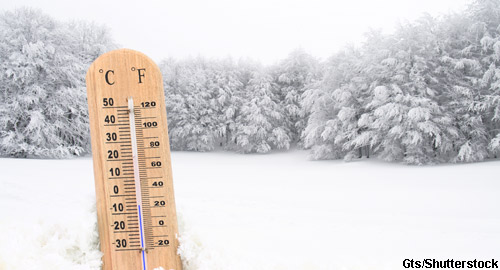 Novel research has linked cold environments—with snow, ice and overall frigid conditions—to an increased risk of developing rheumatoid arthritis (RA) and has rheumatologists in some regions eager for more research. The Swedish study, which was recently published in RMD Open in 2017 and presented as a poster session at the 2016 ACR/ARHP Annual Meeting, concludes that working in cold environments “is associated with increased risk of developing both anti-citrullinated protein antibody (ACPA)-positive and ACPA-negative RA. A dose-response relationship was found between working in cold indoor environment and the risk of developing RA. Moderate additive interaction was observed between exposure to cold environments and exposure to repetitive hand/finger movements.”1,2
Novel research has linked cold environments—with snow, ice and overall frigid conditions—to an increased risk of developing rheumatoid arthritis (RA) and has rheumatologists in some regions eager for more research. The Swedish study, which was recently published in RMD Open in 2017 and presented as a poster session at the 2016 ACR/ARHP Annual Meeting, concludes that working in cold environments “is associated with increased risk of developing both anti-citrullinated protein antibody (ACPA)-positive and ACPA-negative RA. A dose-response relationship was found between working in cold indoor environment and the risk of developing RA. Moderate additive interaction was observed between exposure to cold environments and exposure to repetitive hand/finger movements.”1,2
In an email interview with The Rheumatologist, lead author Pingling Zeng of the Institute of Environmental Medicine at the Karolinska Institute in Sweden says the study was partly prompted by repeated questions from RA patients who would comment on whether cold plays a role in RA. Although some research investigates the association between weather and climate conditions, including temperature and barometric pressure, and RA symptoms, Dr. Zeng describes her team’s research as “the first study that investigated the association between working in cold environments and developing RA.”
The Need for More Research
Dr. Zeng writes, “There is a vast amount of research on RA focusing on the cellular or molecular level to understand the disease pathogenesis. In contrast, relatively [little] research on RA [is] focused on the modifiable environmental risk factors. Providing new knowledge on the environmental risk factors would address patients’ needs and desire to understand why they get the disease and how to prevent their family members from suffering from the same disease. Thus, more research on the modifiable environmental risk factors is needed.”
She adds, “We hope our study will serve as a foundation for scientists to generate relevant etiologic hypotheses and to test these hypotheses using laboratory experiments or interventional studies to better understand the cellular mechanisms of RA.”
Asha Shrestha, MD, a rheumatologist at St. Joseph Healthcare in Bangor, Maine, says more research into the association of the environment and RA development is much needed. “It’s absolutely important, yes,” she says. “I’d encourage those studies.”
Most of Dr. Shrestha’s patients who have arthritis complain of aggravated joint symptoms during the region’s wintry months. She encourages patients to stay warm and try to stay active during the cold weather. However, their outdoor activity level is often limited due to inclement weather and increased risk of falls.
Richard Lai, a rheumatologist at the Great Falls Clinic in Great Falls, Mont., some 125 miles south of the Canadian border, says that winter months can decrease office visits. Patients often cancel appointments because of weather concerns. He also knows little can be done for worsening symptoms during the winter. The few options include increasing the dosage of existing medication(s) and prescribing topical anti-inflammatory gels.
Additional research delving into the links between the environment and RA could help identify potential treatment avenues and prevention options.
“I don’t think a lot of studies are done in colder climates,” says Dr. Lai. “[And] I don’t think a lot of studies have been published to address colder symptoms in terms of treatment—how to manage it better. A lot of times, we go with the guidelines nowadays: stay warm, make sure you take your medicine [and] watch your rheumatoid joint symptoms. But that’s pretty much the extent of how we approach this group of patients. More research would undoubtedly be helpful as far as what to predict, do we have to provide other medicine when it is colder to prevent the flare up, the symptoms or anything.”
The dearth of evidence on the association between working in cold environment and developing rheumatic or musculoskeletal disease has some rheumatologists skeptical of how large a role environment plays in pathology.
“Look, for the autoimmune diseases, the major factor is the immune system,” says Steven Vlad, MD, a rheumatologist at Tufts Medical Center in Boston. “The pathology that causes the autoimmunity, the process the causes the inflammation … things like weather may play a role, but I think that role tends to be minor and probably influences to a certain extent what patients feel.”
Dr. Vlad notes that what patients believe must be taken seriously, particularly as it relates to concerns with weather during the winter months. He also cautions that physicians must be careful with patients who suffer from Raynaud’s phenomenon in which reduced blood flow—often triggered by cold weather—causes numbing of fingers and other areas of the body.
Although rheumatologists eagerly await more research correlating the effect of environment on the development of rheumatic disease, they counsel existing patients to be careful during colder temperatures. Techniques include exercising indoors as much as possible, covering up extremities when outdoors and avoiding exposure to the most hazardous conditions.
“You have to keep warm,” Dr. Vlad says. “And keeping warm doesn’t just mean wearing gloves or boots. … It often means keeping your core warm and making sure that, by keeping your core warm, you maintain circulation.”
Richard Quinn is a freelance writer in New Jersey.
References
- Zeng P, Bengtsson C, Klareskog L, et al. Working in cold environment and risk of developing rheumatoid arthritis: results from the Swedish EIRA case-control study. RMD Open. 2017 Aug 16;3(2):e000488. doi: 10.1136/rmdopen-2017-000488. eCollection 2017.
- Zeng P, Klareskog L, Bengtsson C, et al. Working in cold environment is associated with increased risk of developing rheumatoid arthritis: Results from a Swedish population-based case-control study [abstract]. Arthritis Rheumatol. 2016; 68 (suppl 10).

